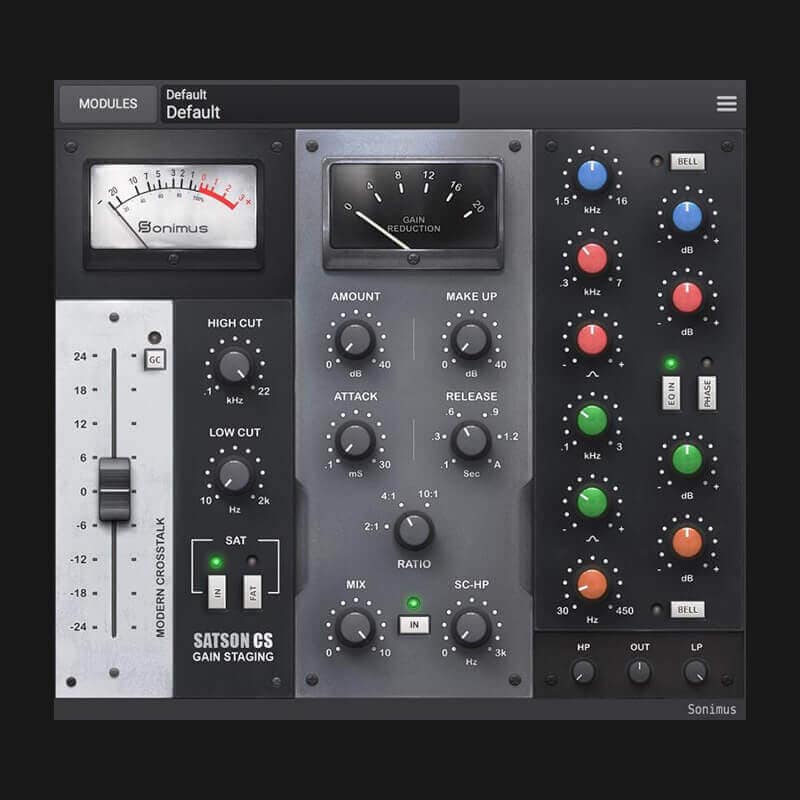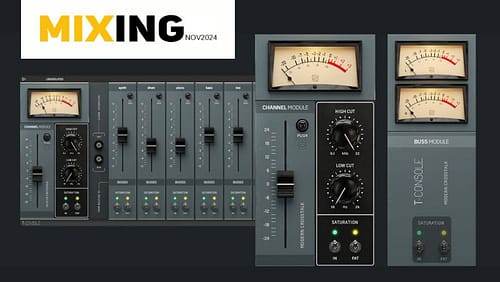In a market where we seemingly get a new (and often great) SSL emulation at least once a year, it takes a lot for me to replace my go to plugins in that ballpark. Satson CS has been an unassuming exception to this rule in my studio though, since it is not a 1:1 SSL emulation, but Sonimus’s own interpretation of that category + decade of console circuitry. It also features a G-Series bus style compressor opposed to a standard G-Series channel compressor, which opens up a ton of additional possibilities. Again, this isn’t a 1:1 bus comp, and has been adapted to better handle a wide variety of channel applications.
Like many examples of the Sonimus lineup, Satson CS is a pretty no frills product overall. It does have some new tricks, like a sidechain HPF in the compressor that goes all the way up to 3000Hz if you only want to compress the upper frequencies to smooth out or tone shape a track this way. It quickly proves that it doesn’t need every single bell and whistle though, and makes up for this in spades with it’s unique, but undoubtedly familiar tone.
Sonically Multi-generational
That is the real highlight of this channel strip; it sounds like a G-Series PLUS something else. An extended, but still tight low end, subtlety forward, punchy mids, and a crisp, further extended high end response that in many ways combines the best aspects of an 80s console and a modern summing mixer/channel strip. From the saturation and emulated crosstalk (more on this later) alone, there is a level of openness and cohesion that is seldom heard in the software world. The top end is so pleasant in fact; it more directly reminds me of my Looptrotter Satur-8/24 summing mixer running through my Serpent Audio SB4001 than it does a lot of seemingly similar plugin options. This makes a little more sense considering the compressor included with Satson CS has more in common with the SB4001 than it does your standard channel compressor.
This is because Sonimus CS blends the line between a decades old sound, and a modern top 40 sound. A G-Series serves as a great mental reference point as to what you may enjoy Satson on, but there are a handful of more delicate applications where I’d rarely touch a SSL, but that I’ve been using Satson CS on regularly.
It seems Sonimus takes this approach to plugin design often, most notably with their SonEQ Pro, which treads ground somewhere between a Pultec EQP-1A and a modern parametric mastering equalizer. The Sonimus is like a G-Series channel strip with not only the standard guitar, drum, and vocal tricks in mind but also program material and buses/subgroups as a whole. There is no perceivable noise floor, as well as a cleaner, more accurate transient response versus how a typical 80s solid state desk sounds. While there may still be applications I want a true, blue G-Series sound, (in my case at least) there are just as many where I want the tonal benefits of a G-Series but with a current day facelift. Think THAT Corporation chips versus the old DBX ones in the original DBX (and SSL) processors, or a CAPI VP28 with Red Dots and Litz transformer vs. an old API 312. Similar, but very much it’s own product, with it’s own advantages and applications.
Depending on how you gain stage Sonimus CS, you can achieve extremely subtle results with a level of transparency that lends itself perfectly to cleaner acoustic guitars, pianos, strings, or high hats where you want a bit of neutral enhancement that won’t add anymore color than you want it to.
Piano (Dry Recording + Reverb)
Piano (Satson CS + Reverb)
For example, there are instances working on certain genres where I may be in a session and the guitar, upright bass, or violin player has an instrument from the 1910s or 1920s. Normally, I would not even think about adding an 80s piece of gear at this point, since it would alter the tone of this near-perfect instrument to the point where it may even be insulting towards the musician. Instead of getting another house or a sports car, they got this instrument, and it better still sound like this instrument when you are done with it, subtleties and all. But I don’t always want to stick to the Forssells and Millenias and Grace Designs of the world, and want to add a bit of enhancement opposed to leaving everything 110% clean. With a low input hanging out around -10 to -20 on the VU meter, some subtle EQ, plus maybe some light compression; I don’t have to worry about one of the worlds mellowest, rich violins suddenly popping out of the speakers like it’s a pop sample (though you can if you want to with CS). In this case, you add texture, and help create a space in the mix for the instrument, but it isn’t an all or nothing situation when it comes to the saturation/total harmonic distortion of the Satson line.
Or you can crank it into the red for all that grabby; in your face goodness we have heard on countless records, especially on drums, guitars, synths, and vocals (especially when using it on a parallel, pre-fader send). This alone is a feat, as I most readily notice the difference between hardware and software when I start driving it at higher levels, as well as in the high end. The saturation of Satson CS doesn’t choke out all of that presence you just worked 3 hours to add in, even when really pushing it hard on a parallel track or distortion bus.
Hip Hop Vocals (Dry + Reverb)
Hip Hop Vocals (Satson CS + Reverb)
Hip Hop Vocals (Satson CS, Fat Switch On + Reverb)
Under the Hood
To make this gain staging even easier, and to get an emulation of a full channel strip, I’ve found myself using Satson CS in tandem with Sonimus Satson or Britson constantly (which also model crosstalk). These products cover the sound of the fader, preamp, summing, and 1st filter stage, and blend beautifully with the processing options of CS. The fader and filter circuitry add more to the sound than you’d think, even when the filters aren’t being used. It’s the reason I love the CAPI VP28, and the reason I love the sound of one of the Sonimus virtual consoles working in tandem with their channel strips.
As the icing on the cake, the GPU hit of every Sonimus product I have tried, including Satson CS is practically nonexistent. Whether I am running it on my old 2011 MacBook Pro I occasionally use for mobile/field recording projects, my Mac Pro, or my new custom PC, I can more or less put infinite instances of anything Sonimus into the DAW without any performance issues. This is especially important for console emulation/summing emulation plugins, since the point is often to use them throughout the mix to get the cumulative effect of multiple tracks sharing a common denominator. This type of processor in general is great because it makes multiple tracks (whether they are sampled or recorded) sound like they were ran through the same desk, at the same time. Just like how putting the same reverb on multiple tracks makes it seem more like they were recorded in the same room. Little touches like this go wonders to sell the believability and cohesiveness of the song.

Future Wishlist
All this being said, I have some dream features I’d love to see on any potential future Satson CS updates. Some additional ratios could go a long way, with everything from a 1.5:1 for mixing and mastering to 20:1 for parallel tracks and drum smashing. Perhaps a 2nd, quicker auto release as well, slower attack settings, or maybe even a mid/side encoder to push this fully into mastering territory. While Satson CS covered every application I wanted to (and then some) with the currently provided features, I think leaning more into the updated, current era influence hinted at by it’s sound would really accentuate Satson’s balance of the best old and new has to offer. It already can be clean enough and airy enough to use on more applications than a normal G-Series model, and this would crank it to 11 in the versatility and fine tuning department.
Mix Bus (Bypassed Satson CS – Nick Rojas)
Mix Bus (Satson CS On – Nick Rojas)
Conclusion
Considering Satson CS is over $100 less than your typical plugin of this style though, and comes with a baked in bus compressor to boot, I think my dreams can easily be put on hold for the time being. Sonimus fulfills every promise it makes and then some. As always, the audio examples I’ve included below are as close to unity gain as possible (often only using Satson CS on the channel to better demonstrate it), so you can form your own opinions. That being said, I still encourage you to try out a demo on some of your own projects. Whether you love the sound of the G-Series, or aren’t the biggest fan, Satson CS is both similar enough to sound nostalgic but new and unique enough to confidently tread it’s own ground. And because of that, it gets an easy recommendation from me.







Leave A Comment
You must be logged in to post a comment.